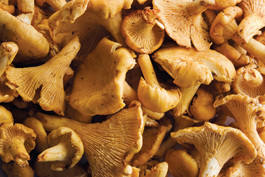home | metro santa cruz index | santa cruz county restaurants | review

Enchanté: Golden chanterelles are just the start of the mycological miracles on display at this weekend's Fungus Fair.
Morel Authority
This weekend's Fungus Faire celebrates the mighty mushroom.
By Christina Waters
In the beginning, there was foraging. Long before there were delis, salad bars and smorgys, humans combed the forests and fields hunting for enticing edibles. It probably didn't take long for successful food gatherers to discover the magical changes that occur immediately after a rain shower. Mushrooms, fungi, fabulous organic shapes, began sprouting on trees, logs, leaves and mossy banks and in verdant fields. And lo, much of this stunning natural phenomena was good to eat—if it didn't kill you. But that's a different story.
Part of the mysterious allure of the mushroom, as well as of its cousins the fungi, yeasts and molds, lies in its sudden eruption. Unlike green plants that live by converting chlorophyll into sugars through photosynthesis, fungi form invisibly, in vast underground networks of filaments called mycelia. Feeding on other organic matter, the mycelium is what makes the mushroom resemble an animal more than a vegetable. The mushroom that pops up above ground is actually the fruiting body of the unseen web. There's no gradual growth from seed to tiny shoot to large botanical entity. With the mushroom it's literally an overnight transformation.
Among the endless reasons to live in the Santa Cruz Mountains is one that mycologists (mushroom experts) know full well. Some of the most delicious and highly prized wild mushrooms love to spring forth after those first rains from the dense oak-leaf floors of our forests. Experts will tell you that this happens—local restaurants might even showcase some of the wild captures on winter menus—but few mycophiliacs will show anyone their prized mushroom hunting grounds. As with the European truffle, the actual locations where edible mushrooms appear are closely guarded secrets.
Nonetheless it's quite possible for anyone willing to crawl around under oak trees during wet weather (!) to discover their own treasure troves of the most sought-after varieties—the sweet butter-yellow golden chanterelle (Cantharellus cibarius) and the supple, earthy black trumpet chanterelle (Craterellus cornucopioides). The experts who will gather at Louden Nelson Center This weekend for the 34th Annual Santa Cruz Fungus Fair will show you what to look for and how to get started.
This year's Fungus Fair offers two days of eye-opening, educational and delicious exhibits and demonstrations. Hundreds of wild mushrooms will be on display, as well as experts available to answer all your questions. Herbalist Bill Schoenbart will deconstruct medicinal mushrooms at 1pm on Sunday. Saturday's cooking demo by mushroom chef Dan Brophy begins at 3pm, and on Sunday (same time) Jozseph Schultz will wok you through some India Joze-style mushroom magic.
The 34TH ANNUAL SANTA CRUZ FUNGUS FAIR happens Saturday-Sunday, Jan. 12-13, at Louden Nelson Center, 301 Center St., Santa Cruz. Tickets at the door are $6 general/$4 seniors and students (kids under 12 free). For complete details, call the Santa Cruz Museum of Natural history at 831.420.6115 or check the Fungus Fair website: www.santacruzmuseums.org.
A Few Fungus Facts
Factoid 1: Underground mycelium networks are among the largest and oldest living organisms. Take the Armillaria ostoyae, a fungus also known as the Shoestring Rot. The aggressive mycelium of this fungus feasts on the hardwood and conifer forests of the Cascade Range, and travels huge distances under the trees to form its immense network of "shoestrings." Even though this fungus survives by attacking and eventually killing the roots of its tree hosts, the process helps to recycle nutrients and encourage further forest growth. Ecology in action, if you will. One such fungal colony in eastern Oregon's Malheur National Forest is currently touted to be the largest such entity in the world, covering (are you sitting down?) over 2,000 acres, or 1,200 football fields. It's also over 2,000 years old! That's one big ol' biomass. Next time you see a cluster of mushrooms, have some respect for its sheer existential vitality.
FACTOID 2: The ancient Romans and Greeks prized mushrooms as gastronomic delicacies—the earliest "cookbook" by Apicius lists many recipes for preparing truffles and boletes. The ancients were also adept in applying the lethal properties of some mushrooms. It was the highly poisonous Amanita muscaria (with its beautiful red cap covered by white spots), administered by his third wife, Agrippina, that ended the illustrious life of Emperor Claudius.
FACTOID 3: When preparing mushrooms for eating, do not soak them in water. Their highly porous bodies will absorb the water and become mushy. Instead brush them off with a dampened paper towel, or with one of those nifty little mushroom brushes.
Send a letter to the editor about this story.
|
|
|
|
|
|